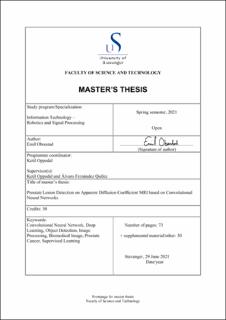| dc.description.abstract | In 2020 there were 1 414 259 new incidences and 375 304 deaths worldwide caused by prostate cancer. The number of cases could increase even further in the future due to higher life expectancy and population growth. Prostate cancer diagnosis consists of several examination steps that are time-consuming, expensive and can involve risk factors. Magnetic resonance imaging can help locate and classify prostate cancer at an early stage, but it suffers from inter-observer variability. Utilizing a single, relative, automated object detector for prostate diagnosing can produce a more comfortable, efficient and less expensive examination process.
This thesis explores the paradigm of supervised learning, and more specifically supervised object detection, on apparent diffusion coefficient images for prostate lesion, with one-stage and two-stage convolutional neural networks architectures. Image pre-processing techniques to increase bounding box area size and data augmentation to alleviate the shortage of data are investigated to improve network performance. Evaluation of detection performance relative to the prostate anatomical zone is conducted. Different lesion classification approaches were conducted to explore the networks ability to classify lesions. The data set used in this thesis consists of 1109 images with 1281 labelled ground truths that have an uneven distribution of examples between the lesion classes. There are instances of lesion ground truth errors, which could diminish the object detector performance.
An average precision of 0.424 was achieved for clinically significant lesions and 0.156 for insignificant lesions, where the network detector produced the most promising results for lesions located in the prostate transition zone. However, the inefficient data set size and possible lesion ground truth errors limit the network to obtain optimal performance results. Data augmentation improved network performance by artificially increasing the data set size. Experiments conducted showed that convolutional neural network architectures have a problem detecting small objects. Cropping and resizing images increased the bounding box dimensions, which improved detection performance. Object detection shows a great potential to be used in hospitals for prostate cancer diagnosis, which could be an influential tool for reducing over-diagnosing. | |
